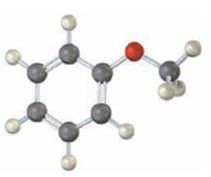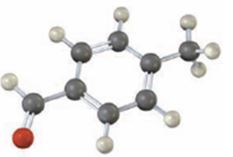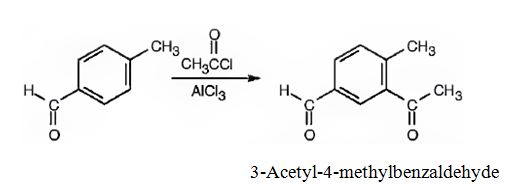
a)

Interpretation:
Draw the products obtained when the compound shown (methoxybenzene) reacts with (i) Br2, FeBr3 and (2) CH3COCl, AlCl3.
Concept introduction:
Aromatic rings can be brominated using Br2 in the presence of FeBr3. The electrophile is Br+. Friedal-Crafts acylation reaction occurs when an
To draw:
The products obtained when the compound shown (methoxybenzene) reacts with (i) Br2, FeBr3 and (2) CH3COCl, AlCl3.
Answer to Problem 24VC
(i) The products obtained when the compound shown (methoxybenzene) reacts with Br2/FeBr3 are p-bromomethoxybenzene and o-bromomethoxybenzene.

(ii) The products obtained when the compound shown (methoxybenzene) reacts with CH3COCl/AlCl3 are p-acetylmethoxybenzene and o-acetylmethoxybenzene.

Explanation of Solution
The methoxy group attached to the benzene ring is an ortho & para directing group. When methoxybenzene is brominated and alkylated it directs the incoming electrophiles, Br+ and CH3CO+ to ortho & para positions.
(i) The products obtained when the compound shown (methoxybenzene) reacts with Br2/FeBr3 are p-bromomethoxybenzene and o-bromomethoxybenzene.

(ii) The products obtained when the compound shown (methoxybenzene) reacts with CH3COCl/AlCl3 are p-acetylmethoxybenzene and o-acetylmethoxybenzene.

b)

Interpretation:
Draw the structures of the products obtained when the compound shown, p-methylbenzaldehyde reacts with (i) Br2, FeBr3 and (2) CH3COCl, AlCl3.
Concept introduction:
Electrophilic substitution of disubstituted benzenes follows three simple rules. (i) If the directing influence of both the substituents reinforce each other, a single product results. (ii) If the directing influences of both the substituent groups oppose each other, the most powerful activating group among them has the dominant influence but usually a mixture of products results. (iii) In meta disubstituted compounds, further substitution in between the groups occurs only rarely, due to steric reasons.
To show:
The major product(s) produced when p-methylbenzaldehyde reacts with (i) Br2, FeBr3 and (2) CH3COCl, AlCl3.
Answer to Problem 24VC
(i) The major product produced when p-methylbenzaldehyde reacts with Br2/FeBr3 is 3-bromo-4-methylbenzaldehyde.

(ii) The major product produced when p-methylbenzaldehyde reacts with CH3COCl/AlCl3 is 3-acetyl-4-methylbenzaldehyde.

Explanation of Solution
The
(i) The major product produced when p-methylbenzaldehyde reacts with Br2/FeBr3 is 3-bromo-4-methylbenzaldehyde.

(ii)The major product produced when p-methylbenzaldehyde reacts with CH3COCl/AlCl3 is 3-acetyl-4-methylbenzaldehyde.

Want to see more full solutions like this?
Chapter 16 Solutions
EBK ORGANIC CHEMISTRY
- Protecting Groups and Carbonyls 6) The synthesis generates allethrolone that exhibits high insect toxicity but low mammalian toxicity. They are used in pet shampoo, human lice shampoo, and industrial sprays for insects and mosquitos. Propose detailed mechanistic steps to generate the allethrolone label the different types of reagents (Grignard, acid/base protonation, acid/base deprotonation, reduction, oxidation, witting, aldol condensation, Robinson annulation, etc.) III + VI HS HS H+ CH,CH,Li III I II IV CI + P(Ph)3 V ༼ Hint: no strong base added VI S VII IX HO VIII -MgBr HgCl2,HgO HO. isomerization aqeuous solution H,SO, ༽༽༤༽༽ X MeOH Hint: enhances selectivity for reaction at the S X ☑arrow_forwardDraw the complete mechanism for the acid-catalyzed hydration of this alkene. esc 田 Explanation Check 1 888 Q A slock Add/Remove step Q F4 F5 F6 A བྲA F7 $ % 5 @ 4 2 3 & 6 87 Click and drag to start drawing a structure. © 2025 McGraw Hill LLC. All Rights Reserved. Terms of Use | Privacy Ce W E R T Y U S D LL G H IK DD 요 F8 F9 F10 F1 * ( 8 9 0 O P J K L Z X C V B N M H He commandarrow_forwardExplanation Check F1 H₂O H₂ Pd 1) MCPBA 2) H3O+ 1) Hg(OAc)2, H₂O 2) NaBH4 OH CI OH OH OH hydration halohydrin formation addition halogenation hydrogenation inhalation hydrogenation hydration ☐ halohydrin formation addition halogenation formation chelation hydrogenation halohydrin formation substitution hydration halogenation addition Ohalohydrin formation subtraction halogenation addition hydrogenation hydration F2 80 F3 σ F4 F5 F6 1 ! 2 # 3 $ 4 % 05 Q W & Å © 2025 McGraw Hill LLC. All Rights Reserved. F7 F8 ( 6 7 8 9 LU E R T Y U A F9arrow_forward
- Show the mechanism steps to obtain the lowerenergy intermediate: *see imagearrow_forwardSoap is made by the previous reaction *see image. The main difference between one soap and another soap isthe length (number of carbons) of the carboxylic acid. However, if a soap irritates your skin, they mostlikely used too much lye.Detergents have the same chemical structure as soaps except for the functional group. Detergentshave sulfate (R-SO4H) and phosphate (R-PO4H2) functional groups. Draw the above carboxylic acidcarbon chain but as the two variants of detergents. *see imagearrow_forwardWhat are the reactions or reagents used? *see imagearrow_forward
- The two pKa values of oxalic acid are 1.25 and 3.81. Why are they not the same value? Show the protontransfer as part of your explanation. *see imagearrow_forwardасть Identify all the bonds that gauche interact with C-OMe in the most stable conformation of the above compound.arrow_forwardPredict the reactants used in the formation of the following compounds using Acid-Catalyzed dehydration reactionarrow_forward
 Organic Chemistry: A Guided InquiryChemistryISBN:9780618974122Author:Andrei StraumanisPublisher:Cengage Learning
Organic Chemistry: A Guided InquiryChemistryISBN:9780618974122Author:Andrei StraumanisPublisher:Cengage Learning Organic ChemistryChemistryISBN:9781305580350Author:William H. Brown, Brent L. Iverson, Eric Anslyn, Christopher S. FootePublisher:Cengage Learning
Organic ChemistryChemistryISBN:9781305580350Author:William H. Brown, Brent L. Iverson, Eric Anslyn, Christopher S. FootePublisher:Cengage Learning EBK A SMALL SCALE APPROACH TO ORGANIC LChemistryISBN:9781305446021Author:LampmanPublisher:CENGAGE LEARNING - CONSIGNMENT
EBK A SMALL SCALE APPROACH TO ORGANIC LChemistryISBN:9781305446021Author:LampmanPublisher:CENGAGE LEARNING - CONSIGNMENT


